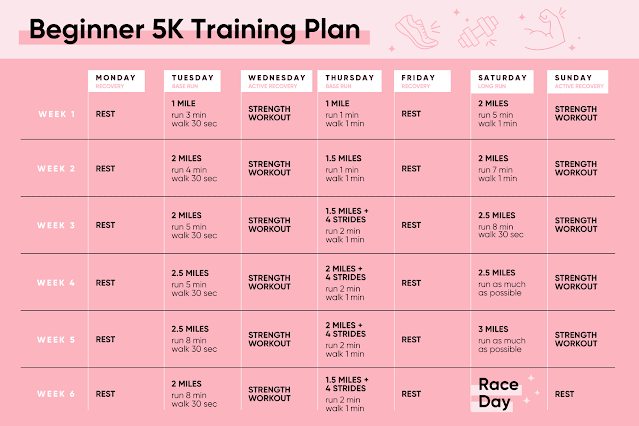Featured Post
- Get link
- X
- Other Apps
How to Build a Customized Weekly Workout Plan
How to Build a Customized Weekly Workout Plan: Your Roadmap to Fitness Success!
Are you ready to take your fitness journey to the next level? Crafting a customized weekly workout plan that aligns with your goals, fitness level, and lifestyle is the secret to achieving long-term success. Whether you’re looking to build muscle, lose weight, improve endurance, or just feel more energized, a well-structured workout plan is your best friend!
But how do you create a plan that works for YOU? Don’t worry—we’ve got you covered! In this guide, we’ll break down the steps to building a personalized weekly workout plan that will help you stay motivated, track your progress, and achieve your fitness goals like a pro. Let’s get started!
Step 1: Set Clear Fitness Goals
Before diving into your workout plan, it’s essential to know exactly what you want to achieve. Ask yourself:
- Do I want to build muscle?
- Am I looking to lose weight or burn fat?
- Is my goal to improve cardiovascular health or endurance?
- Do I want to increase flexibility and mobility?
Once you’ve identified your goals, it’s time to tailor your workouts to align with those objectives. For example, if your goal is to build muscle, your plan should include strength training and progressive overload. If weight loss is your focus, you’ll want to incorporate both cardio and strength training for maximum fat burning.
Step 2: Assess Your Fitness Level
Next, take a moment to evaluate where you are in your fitness journey. Are you a beginner, intermediate, or advanced? This will help you choose the right exercises, sets, and repetitions to ensure you’re challenging yourself without risking injury.
- Beginner: Focus on learning proper form, building endurance, and incorporating full-body exercises.
- Intermediate: You can start adding more complexity to your workouts with additional sets, reps, and advanced variations.
- Advanced: Time to push your limits with heavier weights, advanced training techniques like supersets and drop sets, and high-intensity interval training (HIIT).
By knowing your fitness level, you can create a workout plan that’s both challenging and achievable, which is key to staying motivated.
Step 3: Choose the Right Workout Split
One of the first decisions in crafting your workout plan is how many days you’ll be exercising each week. For most people, a 3 to 6-day split works best, depending on your goals and time availability. Here are a few popular workout splits you can choose from:
Full-Body Routine (Best for Beginners & Time-Savers)
- Days per week: 3
- Workout Focus: Target all major muscle groups in each session.
- Example: Monday, Wednesday, Friday.
- Why it works: This split is ideal for those who are short on time or just getting started. It gives your muscles adequate recovery time between sessions while hitting every muscle group multiple times a week.
Upper/Lower Split (Great for Intermediate Lifters)
- Days per week: 4
- Workout Focus: Alternate between upper-body workouts (push/pull exercises) and lower-body workouts (legs, glutes).
- Example: Monday (Upper), Tuesday (Lower), Thursday (Upper), Friday (Lower).
- Why it works: This split allows for more focus on each muscle group while still giving adequate recovery between sessions. It’s great for muscle building and fat loss!
Push/Pull/Legs Split (Perfect for Advanced Lifters)
- Days per week: 5-6
- Workout Focus: Push exercises (chest, shoulders, triceps), pull exercises (back, biceps), and legs (quads, hamstrings, glutes).
- Example: Monday (Push), Tuesday (Pull), Wednesday (Legs), Thursday (Push), Friday (Pull), Saturday (Legs).
- Why it works: This split maximizes muscle focus, ensuring each muscle group is trained more frequently, leading to quicker progress in strength and size.
Step 4: Mix Cardio and Strength Training
To build a balanced and effective workout plan, you’ll want to incorporate both cardio and strength training. Both have different benefits, and combining them will keep your workouts fun, varied, and well-rounded.
- Cardio: Boosts heart health, burns calories, and improves endurance. Incorporate 2-3 days of cardio into your weekly plan. Options include running, cycling, HIIT, or swimming.
- Strength Training: Helps build lean muscle, boost metabolism, and improve strength. Aim for 3-4 days of strength training each week. Include compound exercises like squats, deadlifts, push-ups, and rows for maximum impact.
A mix of these two will help you lose fat, build muscle, and improve overall fitness.
Step 5: Create a Balanced Routine with Recovery
Rest and recovery are just as important as the workout itself. Overworking your body without giving it time to recover can lead to burnout, injury, and stagnation.
- Recovery: Incorporate rest days into your weekly plan—at least 1 to 2 days. Active recovery, such as yoga, walking, or stretching, is also a great way to keep your body moving without taxing it too much.
- Sleep: Aim for 7-9 hours of quality sleep per night. Sleep is essential for muscle repair, energy restoration, and overall health.
Remember, fitness isn’t just about pushing hard in every session—it’s about balancing effort with recovery to see long-term results.
Step 6: Stay Flexible and Track Your Progress
A great workout plan isn’t set in stone—it should evolve with your progress. Track your performance each week by recording your workouts, weight lifted, or running times. Over time, adjust your plan to increase intensity, try new exercises, and break through plateaus.
Pro tip: Mix up your exercises every 4-6 weeks to keep things exciting and challenge your muscles in new ways!
Sample Customized Weekly Workout Plan
Here’s a sample plan to give you an idea of what a balanced weekly workout could look like:
Monday: Full-Body Strength Training (45-60 minutes)
Tuesday: Cardio (HIIT or Running, 30 minutes)
Wednesday: Upper Body Strength (45 minutes)
Thursday: Active Recovery (Yoga or Walking)
Friday: Lower Body Strength (45 minutes)
Saturday: Cardio (Cycling or Swimming, 30 minutes)
Sunday: Rest or Active Recovery
Final Thoughts:
Building a customized weekly workout plan is the key to achieving your fitness goals. It provides structure, accountability, and a clear path forward. Whether you want to build muscle, burn fat, or just get in better shape, a plan tailored to your needs will keep you motivated, prevent boredom, and make consistent progress possible.
So grab your fitness journal, map out your workouts, and get started today! With dedication, consistency, and the right plan, you'll be crushing your goals in no time. Ready to transform your fitness? Let’s do this! 💪✨
Popular Posts
How to Meal Prep for an Entire Week (With Recipes)
- Get link
- X
- Other Apps









Comments
Post a Comment